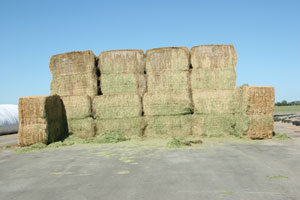 Widespread flooding across Manitoba wiped out the chance of a hay crop this year and is affecting forage supplies this winter.
Widespread flooding across Manitoba wiped out the chance of a hay crop this year and is affecting forage supplies this winter.
According to Glenn Friesen, business development specialist – forages with Manitoba Agriculture, Food and Rural Initiatives, it is estimated a million acres of farmland were flooded this spring and summer.
About two-thirds of that land was in perennial crops, while the remaining third was seeded annually.
Much of the water receded during the summer to allow for a late forage harvest.
The rains began in May and carried through the end of June. Given the delayed planting and perceived lack of forage for the year, it is no surprise that the reported number of greenfeed acres is almost triple the average amount.
“This is due to a combination of new acres from beef producers seeking to replace flooded forage lands, and from new acres by grain producers looking to at least plant some crop with a potential market from the beef producers,” Friesen says.
Annual forages, when planted late in the year, carry a high risk of nitrates. “That’s a silent killer you don’t see until it’s too late,” Friesen says.
Therefore, MAFRI is really promoting it as being a No. 1 priority to watch for this year, and is highly recommending testing feed for nitrates.
A hot and dry July and August did provide for excellent haying weather in the fields that survived the rains. Several crops came off the field early, and the swaths were not ruined by wet weather, resulting in higher yields at higher quality.
Friesen reports second-cut yields above average to excellent for any harvestable land. The heavy precipitation early in the growing season, mixed with extreme heat during July and August, allowed the forages to really put on tonnage.
“Some guys said their stands were so heavy they could hardly walk through them,” he says. “However, third-cut yields were way below average because the lack of August and September rains.”
Forage quality should also be higher than average this year in most parts of Manitoba.
In many cases the flooded lands, often native haystands, were harvested later in the season with lower-quality mature growth.
These combined efforts result in a reasonable amount of roughage available in Manitoba. The amount of higher-quality energy forage is significantly down and most, if not all, is already spoken for, Friesen says.
Producers left to work with lower-quality forages are supplementing them with what they can get their hands on, such as screenings from barley and other grains.
It is important to understand the quality of forage you intend to purchase for feed. “Testing forages is worth it every year,” Friesen says. “The fertility value in one bale can be the difference of $20 to $40.
If you’re buying a few hundred bales, it’s worth spending the value of one bale to have that information.”
Saskatchewan did see above- average hay production for 2011, some of which might make its way into Manitoba.
Any hay being exported to the U.S. is selling as high as 50 to 75 percent greater than normal. This is mostly due to a widespread drought that hit the southern portion of the U.S.
2011 was the third year of flooding for some regions in Manitoba and some farmers have decided to exit the business.
Others are planning to replant lost fields this coming spring, but are left to wait and see if it is even possible after the snowmelt.
Friesen says he believes perennial forage crops will be replaced as soon as possible. Some of those fields were even reseeded this fall. However, with dry weather from August through October, their fate is yet to be seen. PD
PHOTO:
The fertility value in one bale can be the difference of $20 to $40. If you’re buying a few hundred bales, it’s worth spending the value of one bale to have that information. Photo by PD staff.








